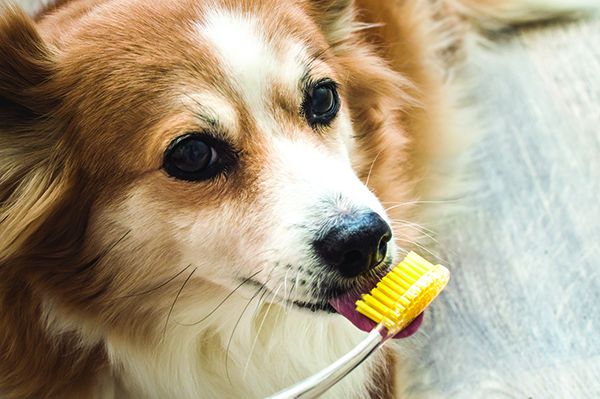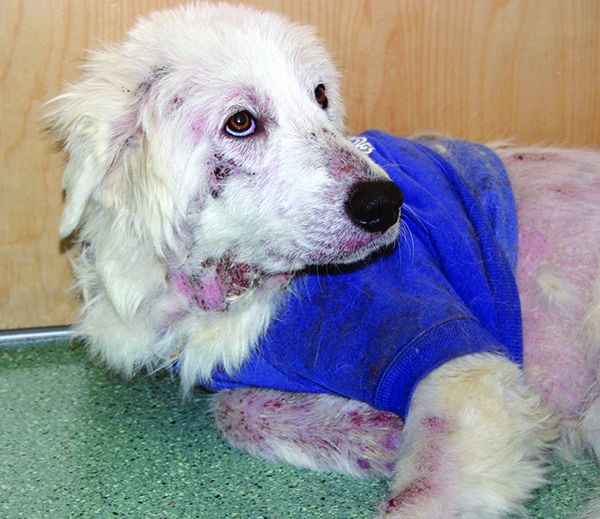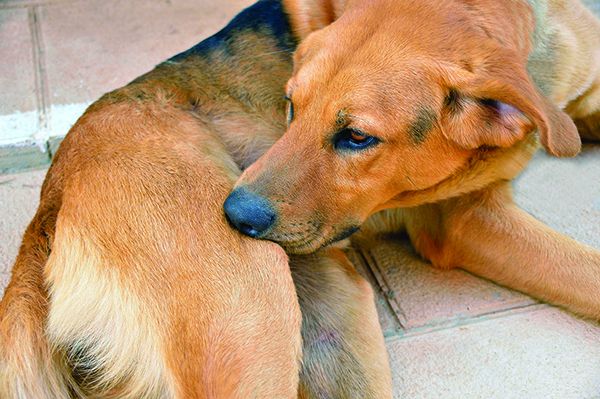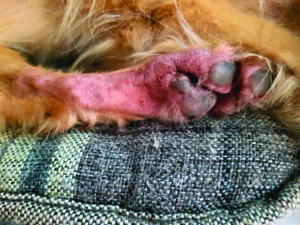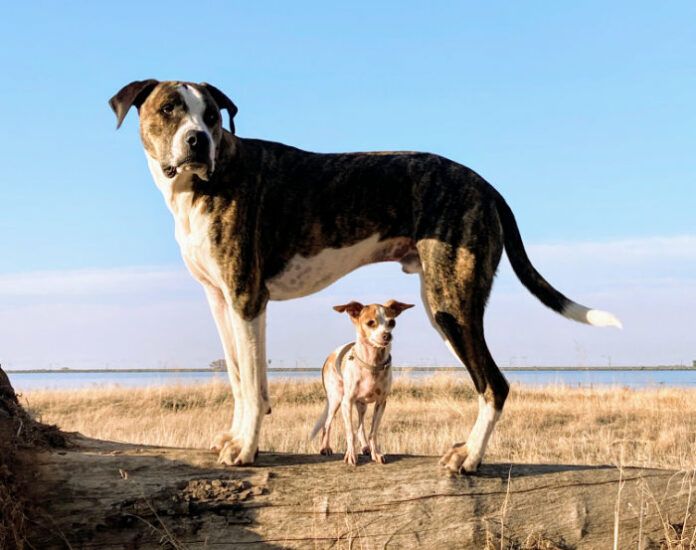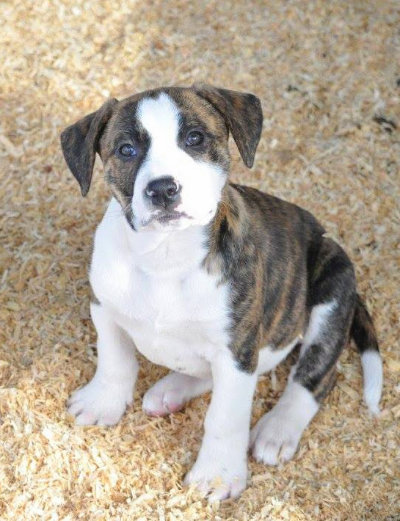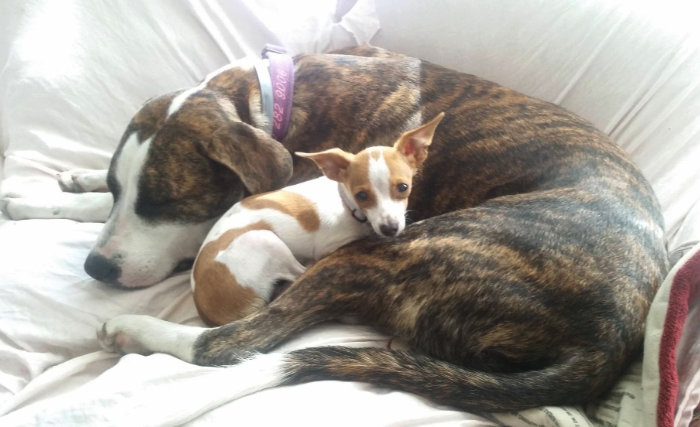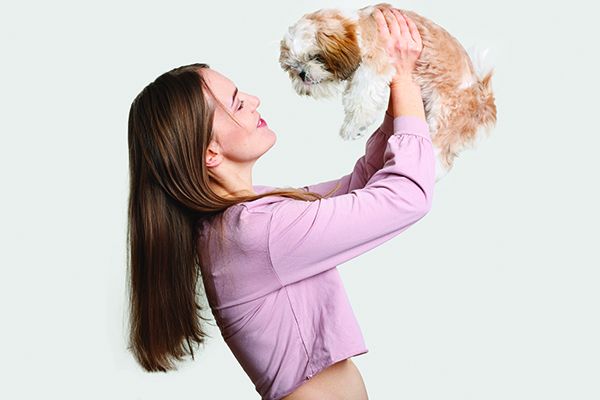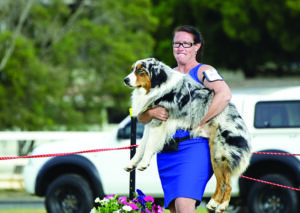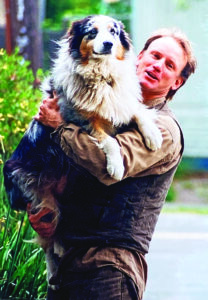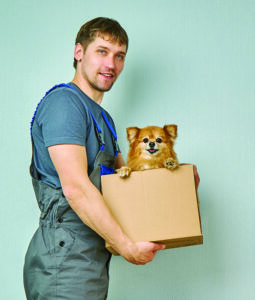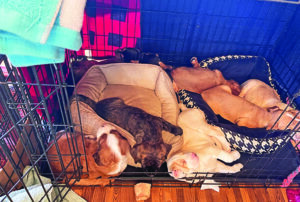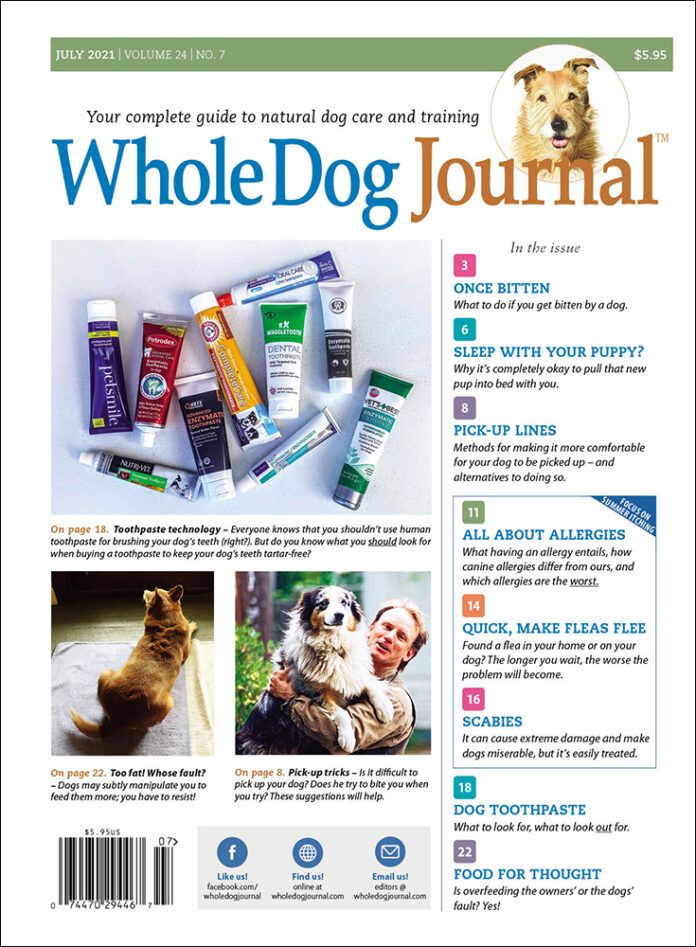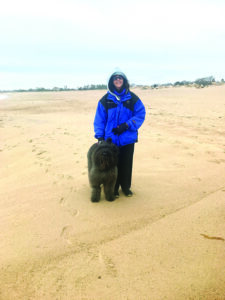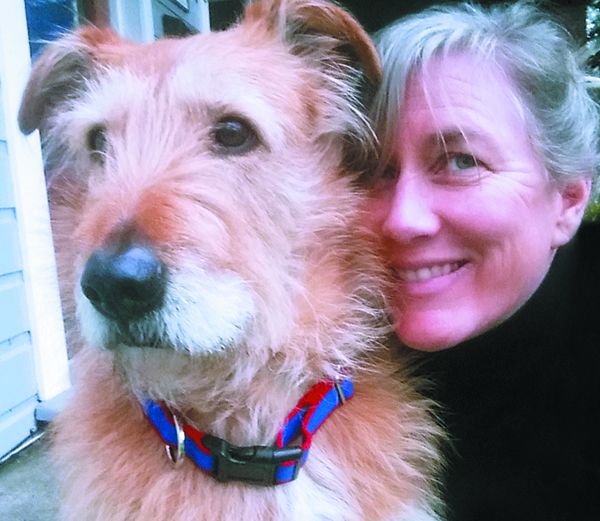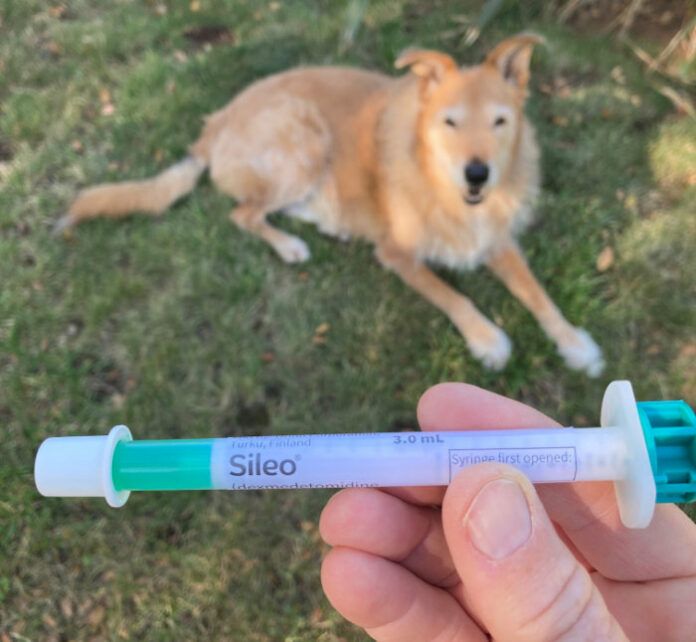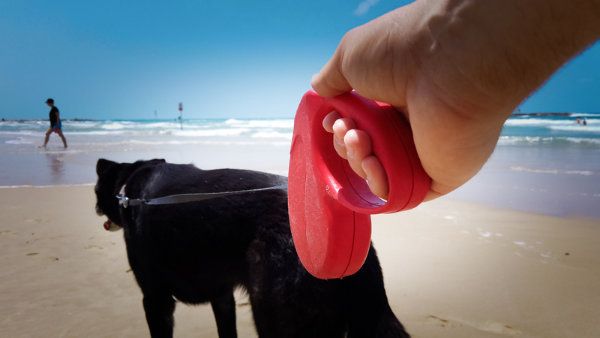The phrase “toothpaste for dogs” sounds like the punchline to a joke – the epitome of a ridiculous product that’s not necessary but is being marketed by an avaricious industry looking to profit by foisting useless gear on unsuspecting dog owners. I’m sure that some comedian somewhere could get a good five minutes of laughs out of the topic.
The truth is, though, that toothpastes that are formulated for pets are helpful. They improve the mechanical effect of the toothbrush, their abrasive ingredients improve the plaque-removing effect of brushing, and their enzymatic ingredients help reduce the population of bacteria present in a dog’s mouth.
Why is this so important? To prevent a cascade of ill effects for your dog. Bacterial overgrowth, also referred to as “biofilm,” causes infection and inflammation when it accumulates below the gum line. Biofilm becomes plaque; plaque promotes the formation of tartar, and both substances give the bacteria more surfaces to cling to and opportunity to proliferate under the gums. And bacteria can not only contribute to bad breath, but also contribute to periodontal disease, which has been linked to severe deleterious effects throughout the body, including the liver, kidney, heart, and lungs. Studies have established a link between canine dental disease and diabetes, “distant neoplasia” (gastrointestinal, kidney, pancreatic, and hematological cancers), chronic inflammation, and early mortality.
To recap: It’s critically important to help your dog keep his teeth clean!
WHAT TO LOOK FOR IN A DOG TOOTHPASTE
We’ll start by mentioning that there is an organization – the Veterinary Oral Health Council (VOHC) – that examines any applicable research studies that might prove the effectiveness of various veterinary dental products as they relate to one of two possible claims: “Helps control plaque” and “Helps control tartar.” Interestingly enough, only one pet toothpaste on the market carries one of those claims: Petsmile Professional Pet Toothpaste, which earned the VOHC seal for “Helps control plaque.” That was enough to make this product our favorite, despite the fact that it’s way more expensive than its competitors.
The one thing that all pet toothpaste manufacturers seem to agree on is that these products should contain an abrasive ingredient. If that sounds alarming, relax: Abrasive ingredients make up at least 50% of human toothpastes!
Commonly used abrasive ingredients include calcium carbonate, sodium bicarbonate (also known as baking soda), sodium chloride (salt), various forms of silica, and dicalcium phosphate.
Pet toothpaste should have a flavor that’s (at a minimum) not aversive to dogs and (at best) pleasant. It’s generally accepted that most dogs don’t particularly enjoy minty flavors, so you’ll see most pet toothpastes flavored with either an artificial sweetener, an artificial peanut butter, or meat “flavor.” We tasted every toothpaste we included in this review and not one, in our opinion, tasted like either meat or peanut butter. Some were vaguely sweet.
That said, dogs have far fewer taste buds than we do – about 1,700 compared to about 9,000 in humans – so, as long as the toothpaste doesn’t taste bad, perhaps the taste isn’t that important.
It’s well established that the mechanical action of brushing is the most effective home care that owners can provide to their dogs. But the use of products that contain antimicrobial agents can increase the efficacy of brushing. Antimicrobial agents reduce the bacterial population in the dog’s mouth and reduce the formation of the biofilm which, left undisturbed, would begin to form plaque and, eventually, tartar.
If your dog resists the brushing process, and you’re able to get only a little antibacterial toothpaste into his mouth, don’t despair. Several studies have indicated that the simple introduction of antimicrobial toothpastes into a dog’s mouth – even without the mechanical brushing action – is more beneficial to the dog than no action being taken at all.
WHAT DOG TOOTHPASTES SHOULD NOT CONTAIN
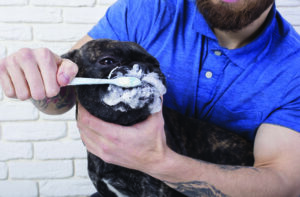
Photo Credit: Oleksii Stasiuk/Dreamstime.com
We hope that all dog owners are aware that they shouldn’t use toothpaste that is formulated for humans when they brush their dogs’ teeth. There are a number of ingredients in human toothpaste that are problematic – and even downright toxic – for dogs. Some of the ingredients are no healthier for humans to swallow than dogs, but you can tell humans not to swallow it, and they (usually) won’t. (Children’s toothpastes contain less fluoride than adult toothpaste because they are less able to follow this instruction than adults.)
Almost all human toothpastes contain fluoride, an effective anti-cavity agent, but it’s not in any pet toothpastes, as dogs are particularly sensitive to this agent; it’s considered a major toxin for them.
Xylitol is a sweetener that’s found in many human toothpastes, but is highly toxic to dogs and is never included in pet toothpaste.
Humans seem to love the foaming action of our toothpastes; it seems to help distribute the cleansing, refreshing agents all around our mouths. But given that we don’t want our dogs to swallow the toothpaste – and they have no way of knowing that, or of rinsing their mouths without swallowing – foaming agents should not be included in a pet toothpaste.
Sodium lauryl sulfate is the most commonly used foaming agent in human toothpastes. It also offers detergent properties (binds with impurities and helps them be rinsed away) and mild antibacterial properties. However, it can cause gastric upset in dogs – and its foaming action is more trouble than its worth in a dog’s mouth. We found it included in just one of the 10 toothpastes we reviewed (Nylabone Tartar Control Pet Toothpaste; see next page).
I doubt that anyone enjoys brushing their dogs’ teeth; with the most cooperative of dogs, it’s a minor inconvenience, and at worst, a major hassle. But if you need a little motivation to convince you to put this chore on your to-do list, consider these dental-health facts:
✔ People who brush their dogs’ teeth regularly are more likely to notice problems such as tooth fractures or chipped teeth, loose teeth, gum inflammation, or growths in the mouth. Early detection of these problems is essential to successful treatment (especially of oral tumors).
✔ Reducing the amount of bacterial plaque at and below the gum line of the teeth is critical for preventing the development of gingival inflammation and periodontal disease. Regular brushing has been shown in many studies to be the most effective means of reducing the amount of plaque on dogs’ teeth; it’s considered the gold standard for maintaining dental health. In fact, one (human) study found that professional cleanings were of little value without regular home care (brushing). Multiple studies have shown that bacterial plaque begins to attach to the tooth surfaces again within 24 hours of cleaning.
CHOOSE WHAT WORKS FOR YOU AND YOUR DOG
We’re not picking any favorites other than the Petsmile product (with its VOHC seal). Use of any of the products will be better than none. We’d recommend trying various products and seeing which ones your dog accepts best.
That said, if your dog already has a significant tartar accumulation on his teeth, we’d definitely suggest a product with a tartar control agent (see the list of ingredients and what they do on page 21). Otherwise, just buy a pet toothpaste, introduce it to your dog as soon as possible, use it regularly, and monitor the appearance of his teeth and gums as time goes by. We think you’ll be amazed at the improvement you will see with regular use of any product.
DOG TOOTHPASTES
| Product Name Maker Information | Price/Size | Ingredients | Comments |
|---|---|---|---|
| Arm & Hammer Completecare Enzymatic Toothpaste www.fetch4pets.com (855) 430-8100 | $6, 6.2 oz | Sorbitol, water, hydrated silica, calcium carbonate, polysorbate 20, tetrasodium pyrophosphate, cellulose gum, sodium chloride, flavor, sodium bicarbonate, zinc gluconate, proteases, thymol | Note that Arm & Hammer name is licensed by Fetch 4 Pets; product not actually made by Arm & Hammer. Flavors: Beef, banana mint, chicken, peanut butter, vanilla ginger. |
| Freshbarks Enzymatic Toothpaste freshbarks.com Phone # not made available | $25, 7 oz (3.5 oz per tube) | Glycerine, aloe, pectin, neem oil, grapefruit seed extract, baking soda (sodium bicarbonate), glucose oxidase (enzymes), natural flavors | Sold only in a pack of two tubes with a unique two-headed toothbrush. One flavor. We’re not crazy about companies that can be reached only via email and that seem to take pains to hide their business location (in this case, the Netherlands). |
| Nylabone Tartar Control Pet Toothpaste nylabone.com (855) 273-7527 | $4,2.5 oz | Sorbitol, hydrated silica, vegetable glycerin, purified water, ascorbic acid phosphate, sodium hexametaphosphate, magnesium aluminum silicate, sodium lauryl sulfate, titanium dioxide, natural flavor, cellulose gum, tetrasodium pyrophosphate, sodium benzoate, potassium sorbate, sodium copper chlorophyllin | Original and peanut butter flavors. We tried the original; we can’t tell you exactly what it tastes like. It’s vaguely sweet and sort of toffee-flavored. “Tartar control” in name is supported by more anti-tartar agents in the ingredients than some of the others. |
| Nutri-Vet Enzymatic Toothpaste nutri-vet.com (877) 729-8668 | $3, 2.5 oz. | Purified water, sorbitol, glycerin, hydrated silica, dicalcium phosphate, xanthan gum, artificial flavor, sodium saccharin, sodium benzoate, glucose oxidase (Aspergillus niger) | The box indicates “Chicken Flavor Paste,” but there is that vague, sweet toffee flavor again. Price seems like a bargain. |
| Petrodex (Sergeant’s Pet Care) Enzymatic Toothpaste Website not made available (800) 224-7387 | $9, 6.2 oz | Sorbitol, dicalcium phosphate, water, hydrated silica, glycerin, poultry digest, dextrose, xanthan gum, acidified calcium sulfate, disodium phosphate duohydrate, potassium sorbate, citric acid, sodium benzoate, Aspergillus niger fermentation extract | Available in peanut butter and poultry flavors. We tried the poultry flavor, which, likely due to an actual poultry-originated ingredient and also its unappealing (to humans) brown color, we didn’t enjoy as much as our test dog did. |
| Petsmile Professional Pet Toothpaste petsmileusa.com (800) 784-7645 **WDJ'S TOP PICK | $27, 4.5 oz. | Water, glycerin, dicalcium phosphate dihydrate, citric acid, Calprox (calcium peroxide), flavor, sodium benzoate, EDTA, cetylpyridinium chloride, carbomer, potassium hydroxide, xanthan gum | This is the only product on our list that carries the seal of the Veterinary Oral Health Council for plaque inhibition – that’s actually a big deal (and justifies the high price); it’s been proven to work. Available in “Rotisserie Chicken” and “London Broil” flavors. We tried the latter; it was inoffensive but didn’t taste like steak. The dogs didn’t object. |
| Vet’s Best Enzymatic Toothpaste vetsbest.com (800) 690-9908 | $5.50, 3.5 oz | Glycerin, aloe, pectin, neem oil, grapefruit seed extract, sodium bicarbonate (baking soda), glucose oxidase (enzymes), and natural flavors | Vet’s Best offers a money-back guarantee if you are not satisfied with the product. This is the most “natural” product included here. Comes in one unspecified flavor; tastes like aloe but also slightly soapy. No objections from the dogs. |
| Vet’s Preferred Advanced Enzymatic vetspreferred.co (855) 270-3578 | $13, 3 oz. | Water, silica, sorbitol, peanut butter flavor, saccharomyces enzymes, sodium carboxymethyl cellulose, polysorbate 20, xanthan gum, potassium sorbate, sodium benzoate | Vet’s Preferred offers a money-back guarantee if you are not satisfied with the product. Available in one flavor: peanut butter. Our test dogs are good sports but we really didn’t like the taste of this. |
| Virbac C.E.T. Enzymatic Toothpaste us.virbac.com (800) 338-3659 | $10, 2.5 oz | Sorbitol, purified water, dicalcium phosphate anhydrous, hydrated silica, glycerin, poultry digest, dextrose, xanthan gum, titanium dioxide, sodium benzoate, potassium thiocyanate, glucose oxidase, lactoperoxidase | Virbac described this a “dual-enzyme system toothpaste” and it does, in fact, contain multiple antimicrobials. Comes in beef, malt, poultry, seafood, and vanilla mint flavors. We tried the poultry; the dogs liked it. |
| Waggletooth Dental Toothpaste waggletooth.com (800) 569-8616 | $16, 4 oz. | Water, glycerin, xanthan gum, peppermint oil, salmon oil, grapefruit seed extract, rosemary oil, thyme oil, dried Bacillus subtils fermentation product, dried Bacillus licheniformis fermentation product, and grape seed extract | This product was developed by a dentist (rather than a veterinarian), and it takes a novel approach with the “targeted oral probiotics,” herbal extracts, and essential oils in its formula. One flavor; tastes just like you would imagine a product that contains peppermint and thyme would taste. |
INGREDIENTS IN PET TOOTHPASTES AND WHAT THEY DO
The following are ingredients that are commonly found in pet toothpastes. They are listed alongside their mode of action – or purported mode of action – the reason they are presumably included. Not all ingredients used by various manufacturers have proven to perform the tasks for which they were included in this application.| Ingredient | Action |
|---|---|
| Aloe | Antibacterial, anti-inflammatory |
| Ascorbic acid phosphate | Biofilm inhibitor |
| Calcium carbonate | Abrasive |
| Calcium peroxide | Whitener |
| Carbomer | Gelling agent |
| Cellulose gum | Thickener, stabilizer |
| Cetylpyridinium chloride | Antiseptic |
| Dextrose | Sweetener |
| Dicalcium phosphate | Abrasive, tartar control agent |
| EDTA (edathamil) | Reduces biofilm |
| Glucose oxidase | Antibacterial, helps break down plaque |
| Glycerin (also known as glycerine and glycerol) | Humectant (retains moisture, keeps product from drying out), improves gel texture |
| Grapefruit seed extract | Antibacterial |
| Grape seed extract | Antibacterial |
| Hydrated silica | Abrasive |
| Lactoperoxidase | Antibacterial |
| Neem oil | Antibacterial |
| Pectin | Thickener, gelling agent |
| Polysorbate 20 | Surfactant (reduces a liquid’s surface tension, thereby increasing its spreading and wetting properties); emulsifier (stabilizer, keeps product from separating) |
| Poultry digest | Flavoring agent |
| Potassium hydroxide | Neutralizes the acidic pH imbalance caused by other chemicals used in toothpaste |
| Potassium sorbate | Preservative |
| Potassium thiocyanate | Reduces gingival inflammation and supragingival plaque |
| Saccharomyces enzymes | Antibacterial |
| Sodium chloride (salt) | Abrasive |
| Sodium benzoate | Preservative |
| Sodium bicarbonate (baking soda) | Abrasive, mild disinfectant, fungicide (may change a dog’s urinary pH) |
| Sodium carboxymethyl cellulose | Stabilizer |
| Sodium copper chlorophyllin | Antimicrobial |
| Sodium lauryl sulfate | Detergent |
| Sodium saccharin | Sweetener |
| Sorbitol | Sweetener, thickener, humectant |
| Tetrasodium pyrophosphate | Tartar control agent |
| Titanium dioxide | White pigment, thickener |
| Xanthan gum | Thickener, stabilizer (keeps ingredients from separating) |


